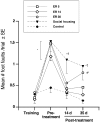Efficacy of rehabilitative experience declines with time after focal ischemic brain injury
- PMID: 14762143
- PMCID: PMC6793570
- DOI: 10.1523/JNEUROSCI.3834-03.2004
Efficacy of rehabilitative experience declines with time after focal ischemic brain injury
Abstract
To maximize the effectiveness of rehabilitative therapies after stroke, it is critical to determine when the brain is most responsive (i.e., plastic) to sensorimotor experience after injury and to focus such efforts within this period. Here, we compared the efficacy of 5 weeks of enriched rehabilitation (ER) initiated at 5 d (ER5), ER14, or ER30 after focal ischemia, as judged by functional outcome and neuromorphological change. ER5 provided marked improvement in skilled forelimb reaching ability and ladder-rung- and narrow-beam-walking tasks and attenuated the stroke-induced reliance on the unaffected forepaw for postural support. ER14 provided improvement to a somewhat lesser extent, whereas recovery was diminished after ER30 such that motor function did not differ from ischemic animals exposed to social housing. To examine potential neural substrates of the improved function, we examined dendritic morphology in the undamaged motor cortex because our previous work (Biernaskie and Corbett, 2001) suggested that recovery was associated with enhanced dendritic growth in this region. ER5 increased the number of branches and complexity of layer V neurons compared with both social housing and control animals. Dendritic arbor after ER14 (although increased) and ER30 did not differ from those exposed to social housing. These data suggest that the poststroke brain displays heightened sensitivity to rehabilitative experience early after the stroke but declines with time. These findings have important implications for rehabilitation of stroke patients, many of whom experience considerable delays before therapy is initiated.
Figures








References
-
- Adkins DL, Bury SD, Jones TA (2002) Laminar-dependent dendritic spine alterations in the motor cortex of adult rats following callosal transection and forced forelimb use. Neurobiol Learn Mem 78: 35–52. - PubMed
-
- Barbay S, Plautz EP, Friel KM, Frost SB, Stowe AM, Dancause N, Wang H, Nudo RJ (2001) Delayed rehabilitative training following a small ischemic infarct in nonhuman primate primary motor cortex (M1). Soc Neurosci Abstr 27: 931.4.
-
- Belichenko PV, Mattsson B, Johansson BB (2001) Neuronal and fibre organization in neocortical grafts placed in post-ischaemic adult rat brain: a three-dimensional confocal microscopy study. J Comp Pathol 124: 142–148. - PubMed
-
- Biernaskie J, Corbett D, Peeling J, Wells J, Lei H (2001) A serial MR study of cerebral blood flow changes and lesion development following endothelin-1-induced ischemia in rats. Magn Reson Med 46: 827–830. - PubMed
Publication types
MeSH terms
LinkOut - more resources
Full Text Sources
Other Literature Sources
Medical
